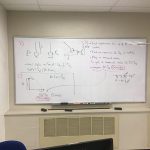
Faculty and staff members have undertaken herculean teaching efforts in for both the fall, summer, and and spring semesters due to the COVID pandemic. The transition to remote and hybrid courses, while challenging, also allowed faculty to re-envision their courses and adapt their teaching methods. Faculty have embraced the “Together We Continue” motto to continue to do all the good things the department does, including dedication to teaching.
Across the department, there have been a mix of teaching modalities. Everyone had to adapt to fully remote offerings in the spring on short notice – which truly was a feat. Summer courses were revised so that they could be taught completely remotely. In the fall, some smaller classes were held face-to-face, some classes were hybrid, where there was a mix of face-to-face and online teaching, and some were completely online. Because of our wide variety of courses, the need for flexibility in the pandemic, and the different goals and methods in each class, every faculty member had their own response to the challenge of teaching in the pandemic.
Facing the challenge of effectively engage with students, Marty Gelfand, the associate chair for academics, chose to teach 100% online. Gelfand, when choosing how to teach online, noted he wanted an arrangement which would be robust with respect to technical failures, but as interactive as possible within that constraint. Thus, Gelfand has pre-recorded lectures, using screen and audio capture app on a tablet, in roughly 5-10 minute chunks and he has uploaded them to YouTube, which are available in advance of the synchronous lecture meetings.
Meanwhile, the board work produced during the lecture recording is in a PDF file which is also made available to the students. Gelfand said that “during class sessions, students watch these lecture segments, and in between those segments we have time for questions, discussions, and mini–exercises. In most other ways, the class remained the same.” Indeed, Gelfand observes— despite difficulties with internet connections and students in distant time zones —student performance is very close to previous years. “Even if they can’t take part in the synchronous class sessions, they don’t have to rely just on the text and other student’s notes,” Gelfand adds.
Master Instructor Brian Jones likewise made some adjustments. Jones said, “I have adapted the in person lectures to be brisk, scripted affairs that each tell a story, through problems, demonstrations, and audiovisual resources. These have proven to be quite popular.”
Knowing student success might suffer while there was a reduced in-person class hours, Jones dramatically increased support for students outside of normal class hours—he’s doubled the hours for evening problem sessions, tripled the means by which students can take part in these sessions (in person, over Zoom, or over Piazza), and he has assigned a team of learning assistants to serve as homework coaches, to give feedback and support. Students taking advantage of these increased supports are doing, Jones said, “better than ever.” Jones also noted, however, “there are a large number of students who are falling through the cracks. I’ve always sought to give every student a chance to succeed, but without some face-to-face interaction, it is impossible to catch them all.”
While many in the department have had their doubts going into the semester, CSU has been able to sustain face-to-face instruction for so long this term, even though there are notable tradeoffs between technological robustness and pedagogical effectiveness. The greater college response is also praised by Jones, who said, “I have been very grateful for the support of the Department in this time, and for the clear messaging from the College. The additional resources and the clear guidance that I have received has made the work possible.”
As for the faculty’s ultimate advice to students? Gelfand said: “Don’t hesitate to reach out to your course instructors. It’s impossible for us to see what’s going on with you when you’re a black rectangle on Zoom.” Jones added, “I appreciate your willingness to engage and learn despite the challenges.”


